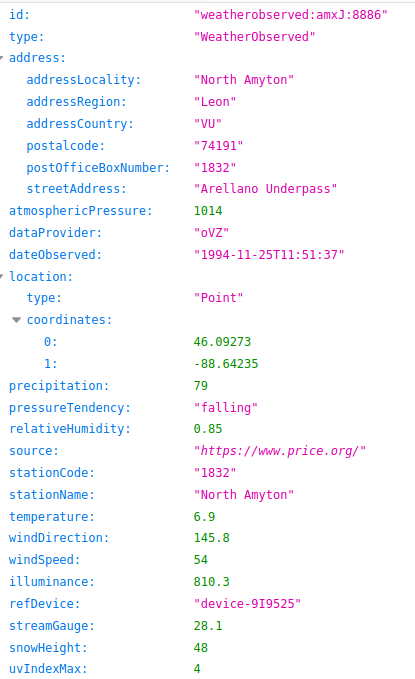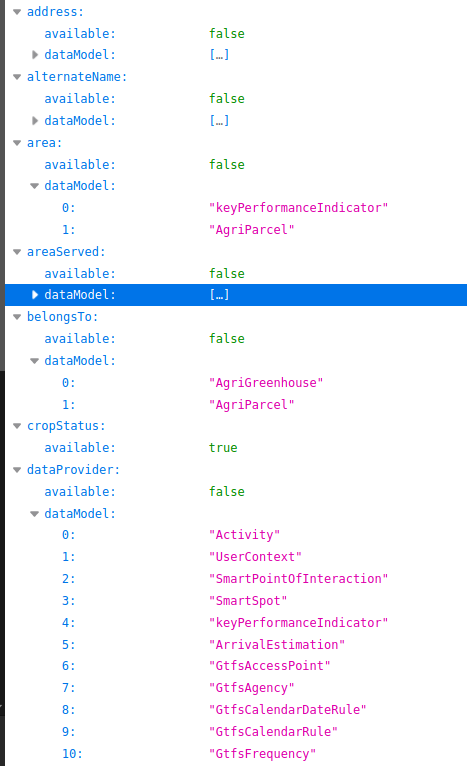Thanks to user jpnbastos that detected an issue on the specification of data model of OnStreetParking documentation it has been updated with several DATEX 2.3 terms and enumerations.
The schema.json has been updated accordingly to the specification.
Thanks to user jpnbastos that detected an issue on the specification of data model of OnStreetParking documentation it has been updated with several DATEX 2.3 terms and enumerations.
The schema.json has been updated accordingly to the specification.
The @context, located on the root of the github repository, of the initiative is now updated automatically.
The long URLs are now completely significative because either they point to the original URL of the property or they point to the terms.jsonld file where the definitions based on the existing data models are present.
Harmonization repository is dedicated to those data models that are mostly accepted and only requirements of consistency, complete documentation and examples availability.
Here there is a list of coming data models in different domains:
Battery
StorageBattery
StorageBatteryDevice
StorageBatteryMeasurement
Energy
ACMeasurement
InverterDevice
PhotoVoltaicDevice
PhotovoltaicMeasurement
Environment
ElectroMagneticObserved
PhreaticLevel
RainFallRadarObservation
Ports
BoatAtuthorized
BoatPlacesAvailable
BoatPlacesPricing
SeaportFacilities
Smart cities
CityWorks
StationDescription
We’ve submitted into the utils directory a short script for installing and running an instance of NGSI v2 and to create your first entity and to list it. It is not a complete guide which is available at FIWARE mains page in this link.
# 1.- if your are coming from a clean installation
sudo docker pull mongo:3.6
sudo docker pull fiware/orion
sudo docker network create fiware_default
sudo docker run -d –name=mongo-db –network=fiware_default –expose=27017 mongo:3.6 –bind_ip_all –smallfiles
sudo docker run -d –name fiware-orion -h orion –network=fiware_default -p 1026:1026 fiware/orion -dbhost mongo-db
# 2.- In case you already had a installation it is better to run these instructions
docker stop fiware-orion
docker rm fiware-orion
docker stop mongo-db
docker rm mongo-db
docker network rm fiware_default
# 3.- Check that your installation is up and running
curl -X GET ‘http://localhost:1026/version’
# 4.- Create your first entity
curl -iX POST ‘http://localhost:1026/v2/entities’ -H ‘Content-Type: application/json’ -d ‘
{
“id”: “urn:ngsi-ld:PhotovoltaicDevice:PhotovoltaicDevice:MNCA-PV-T2-R-012”,
“type”: “PhotovoltaicDevice”,
“name”: {
“type”: “Property”,
“value”: “DEVICE-PV-T2-R-012”
},
“alternateName”: {
“type”: “Property”,
“value”: “AirPort – global Observation”
},
“description”: {
“type”: “Property”,
“value”: “Photo-voltaic Device description”
},
“location”: {
“type”: “GeoProperty”,
“value”: {
“type”: “Point”,
“coordinates “: [43.664810, 7.196545]
}
},
“address”: {
“type”: “Property”,
“value”: {
“addressCountry”: “FR”,
“addressLocality”: “Nice”,
“streetAddress”: “Airport – Terminal 2 – Roof 2 – Local 12”
}
},
“areaServed”: {
“type”: “Property”,
“value”: “Nice Aeroport”
},
“refDevice”: {
“type”: “Relationship”,
“value”: “urn:ngsi-ld:Device:PV-T2-R-012”
},
“brandname”: {
“type”: “Property”,
“value”: “Canadian Solar”
},
“modelName”: {
“type”: “Property”,
“value”: “CS6P-270P”
},
“manufacturerName”: {
“type”: “Property”,
“value”: “Canadian Solar EMEA GmbH,”
},
“serialNumber”: {
“type”: “Property”,
“value”: [“CSPV270P-SN1804L6J34Z8742H”,
“CSPV270P-SN1804L6J34Z8743H”,
“CSPV270P-SN1804L6J34Z8744H”,
“CSPV270P-SN1804L6J34Z8745H”,
“CSPV270P-SN1804L6J34Z8746H”
]
},
“application”: {
“type”: “Property”,
“value”: “electric”
},
“cellType”: {
“type”: “Property”,
“value”: “polycrystalline”
},
“instalationMode”: {
“type”: “Property”,
“value”: “roofing”
},
“instalationCondition”: {
“type”: “Property”,
“value”: [“extremeHeat”, “extremeCold”, “extremeClimate”, “desert”]
},
“possibilityOfUsed”: {
“type”: “Property”,
“value”: “stationary”
},
“integrationMode”: {
“type”: “Property”,
“value”: “IAB”
},
“documentation”: {
“type”: “Property”,
“value”: “https://www.myDevicePV.Cn”
},
“owner”: {
“type”: “Property”,
“value”: [“Airport-Division Maintenance”]
},
“cellDimension”: {
“type”: “Property”,
“value”: {
“length”: 16.0,
“width”: 9.0,
“thickness”: 2.3
}
},
“moduleNbCells”: {
“type”: “Property”,
“value”: 60
},
“moduleDimension”: {
“type”: “Property”,
“value”: {
“length”: 1600,
“width”: 975,
“thickness”: 3.75
}
},
“panelNbModules”: {
“type”: “Property”,
“value”: 1
},
“panelDimension”: {
“type”: “Property”,
“value”: {
“length”: 1638,
“width”: 982,
“thickness”: 40
}
},
“panelWeight”: {
“type”: “Property”,
“value”: 18
},
“arealWeight”: {
“type”: “Property”,
“value”: 32
},
“maxPressureLoad”: {
“type”: “Property”,
“value”: {
“hail”: 2500,
“snow”: 5400,
“wind”: 2400
}
},
“NominalPower”: {
“type”: “Property”,
“value”: 270
},
“MaximumSystemVoltage”: {
“type”: “Property”,
“value”: 1000
},
“applicationClass”: {
“type”: “Property”,
“value”: “A”
},
“fireClass”: {
“type”: “Property”,
“value”: “C”
},
“pTCClass”: {
“type”: “Property”,
“value”: 92.1
},
“nTCClass”: {
“type”: “Property”,
“value”: 88.3
},
“protectionIP”: {
“type”: “Property”,
“value”: “IP67”
},
“moduleSTC”: {
“type”: “Property”,
“value”: {
“Pmax”: 270,
“Umpp”: 30.8,
“Impp”: 8.75,
“Uoc”: 37.9,
“Isc”: 9.32
}
},
“moduleNOCT”: {
“type”: “Property”,
“value”: {
“Pmax”: 196,
“Umpp”: 28.1,
“Impp”: 6.97,
“Uoc”: 34.8,
“Isc”: 7.55
}
},
“moduleYieldRate”: {
“type”: “Property”,
“value”: 16.79
},
“panelOperatingTemperature”: {
“type”: “Property”,
“value”: {
“min”: -40,
“max”: 85
}
},
“cellOperatingTemperature”: {
“type”: “Property”,
“value”: {
“min”: 45,
“max”: 2
}
},
“temperatureCoefficient”: {
“type”: “Property”,
“value”: {
“Pmax”: -0.41,
“Uoc”: -0.31,
“Isc”: 0.053
}
},
“performanceLowIrradiance”: {
“type”: “Property”,
“value”: 96.5
},
“panelLifetime”: {
“type”: “Property”,
“value”: 30
},
“panelYieldCurve”: {
“type”: “Property”,
“value”: [“95.0”, “92.5”, “90.0”, “87.5”, “85.0”, “80.0”]
},
“panelYieldRate”: {
“type”: “Property”,
“value”: 0.5
},
“panelTiltReference”: {
“type”: “Property”,
“value”: {
“min”: 28,
“max”: 37
}
}
}
‘
# 5.- List the entity you have created
curl -G -X GET ‘http://localhost:1026/v2/entities’ -d ‘options=keyValues’
We are in the way of creating a service for testing purposes for getting payloads according to a data model.
The service is under debugging, so it cannot be trusted for production purposes. Let us know issues here
In order to access it has to access this URL (https://smartdatamodels.org/extra/payload_generator.php) with these two parameters token and dataModel
I.e. with a weather observation in the link below:
https://smartdatamodels.org/extra/payload_generator.php?token=sSdme8954c9&dataModel=%22WeatherObserved (reload page several times for generation)
In the production stage, there will be necessary a token in order to, if necessary, to limit the access for a single user. Additionally, it should be available the options of normalized and keyvalues and for the NGSI v2 and LD.

We are in the way of creating a service for those contributors willing to contribute with a complete data model.
The service is under debugging, so it cannot be trusted for production purposes. Let us know issues here
In order to access it has to access this URL (https://smartdatamodels.org/extra/check_properties.php) with this parameter ?urlSchema=[url of the raw access o the JSON schema]
I.e. a complete link could be
It returns a JSON payload indicating if this property is available for use (not used in any other data model) or in the case it is already being used what data models are currently using.

Whenever there is measurement it could be necessary to use the unitCode for setting the units for the value.
Now the guidelines for the data model’s creation include the place to find out these unit codes. See section units.
The list of UN/CEFACT Common Code (3 characters) can be download from this page. Or the list directly from here.
The greenEnergy Subject now compiles two data models GreenEnergyGenerator and GreenEnergyMeasurement inherited (recover) from former synchronicity project.
Thanks to Esteban Rivas, and his entity the La Factoria BikeIn.
Thanks to the contribution of the University of Cantabria and the migration of data models from synchronicity project, now there is a new data model for Store in the repository of Point of Interest.
You can see the contributors which are the ones in the global repository belonging to University of Cantabria.
It takes a while to update the README.md and other documents.
In order to reduce the amount of work in the contribution of data models, we have a script that generates the key-values format of a normalized NGSI LD payload.
It has been operated on 46 data models currently in the repository.
In a close future instead of submitting 4 examples, it will be only necessary to include 2 examples, the normalized payloads for NGSI v2 and NGSI LD (the other two would be generated automatically).